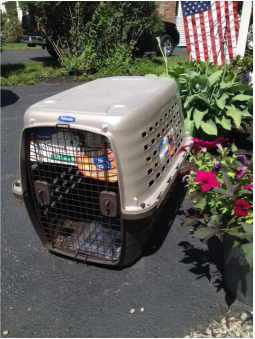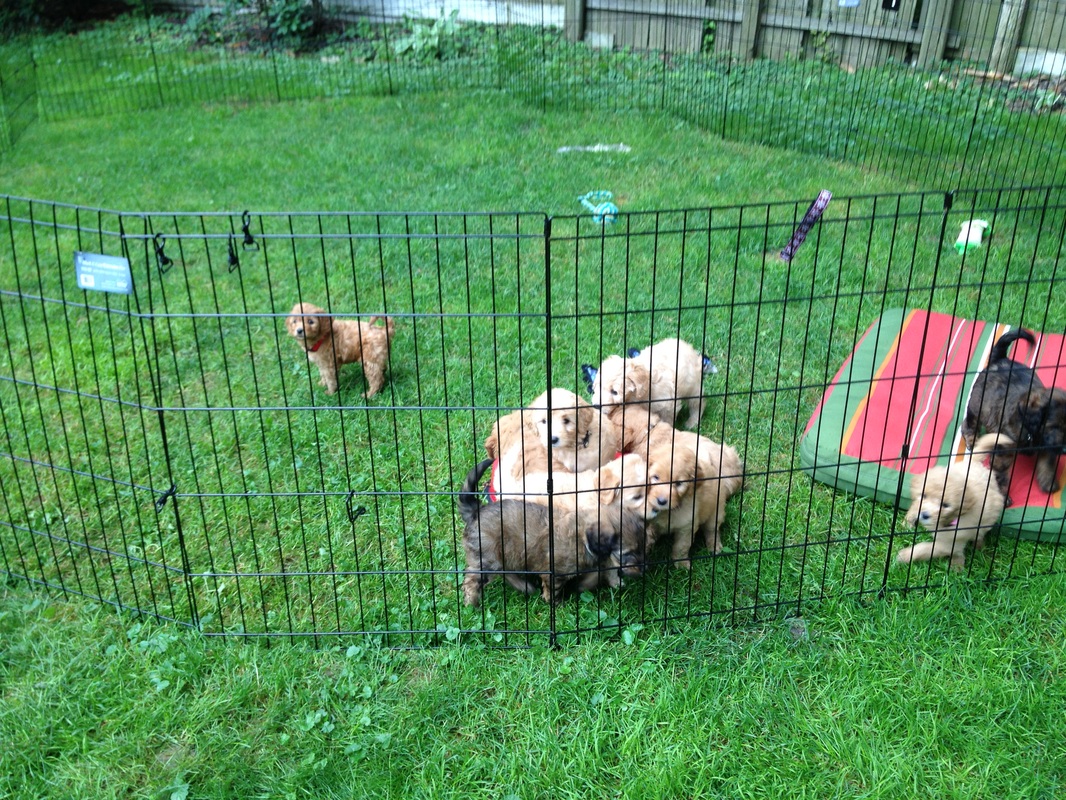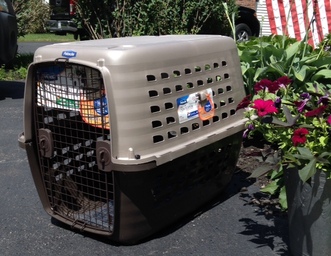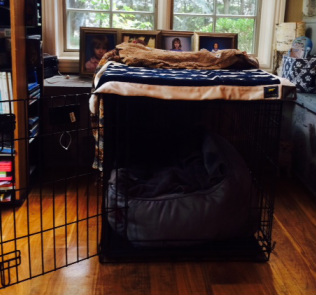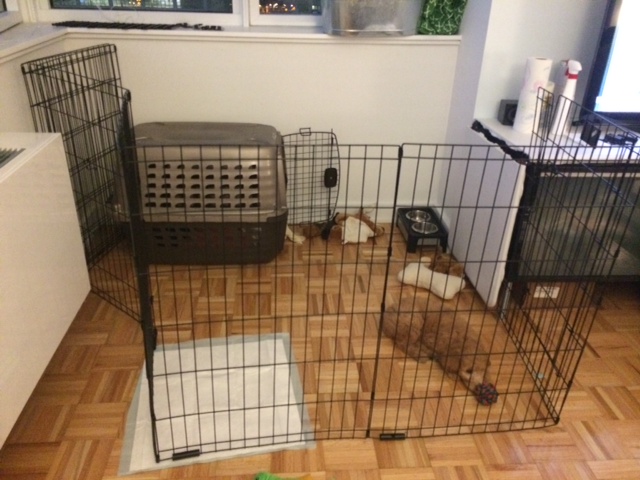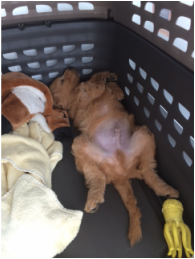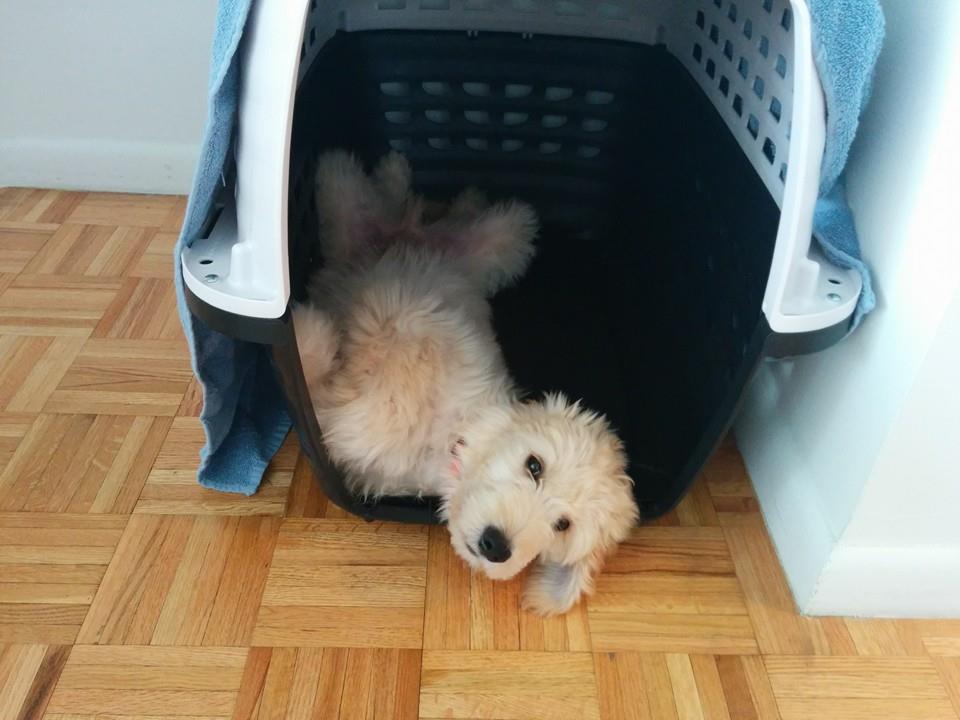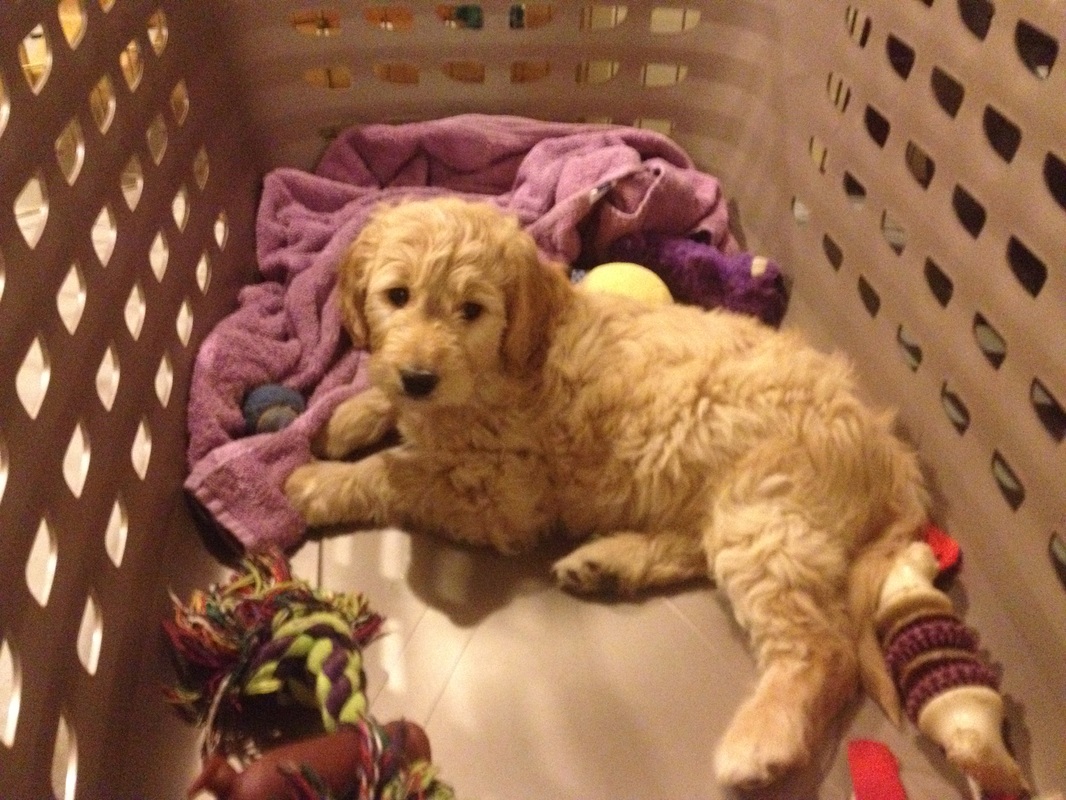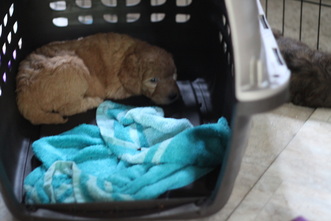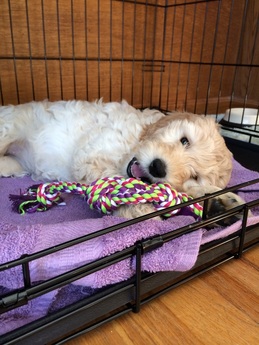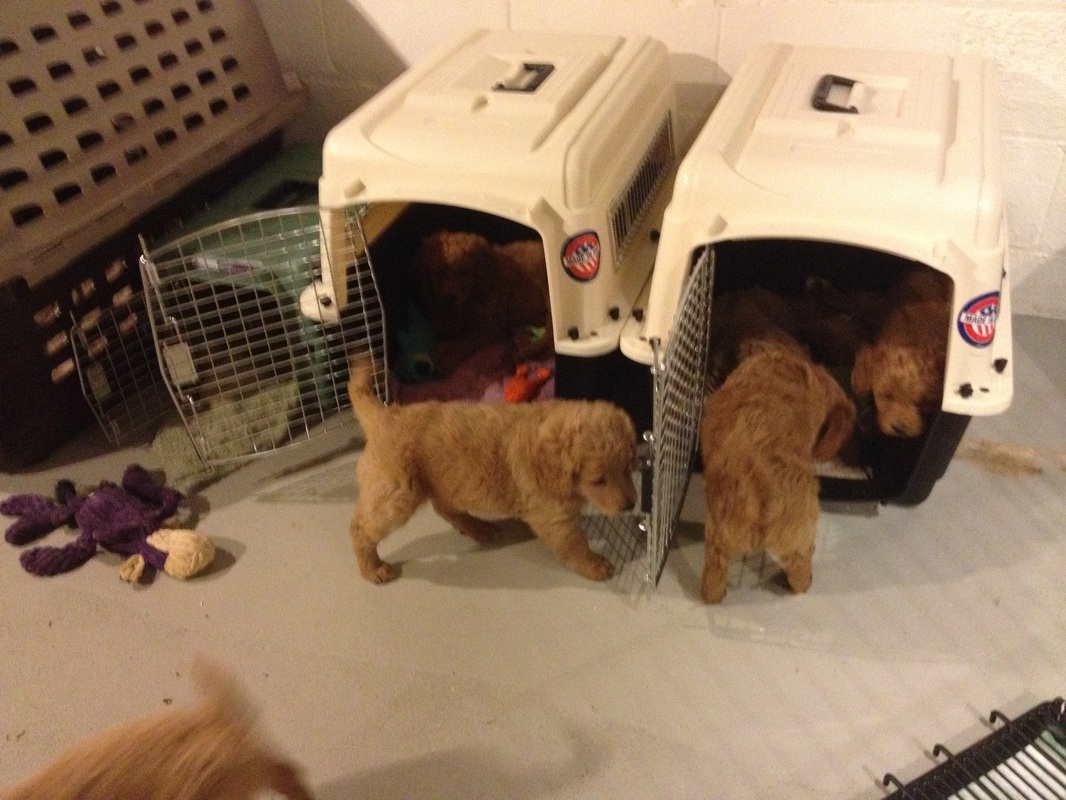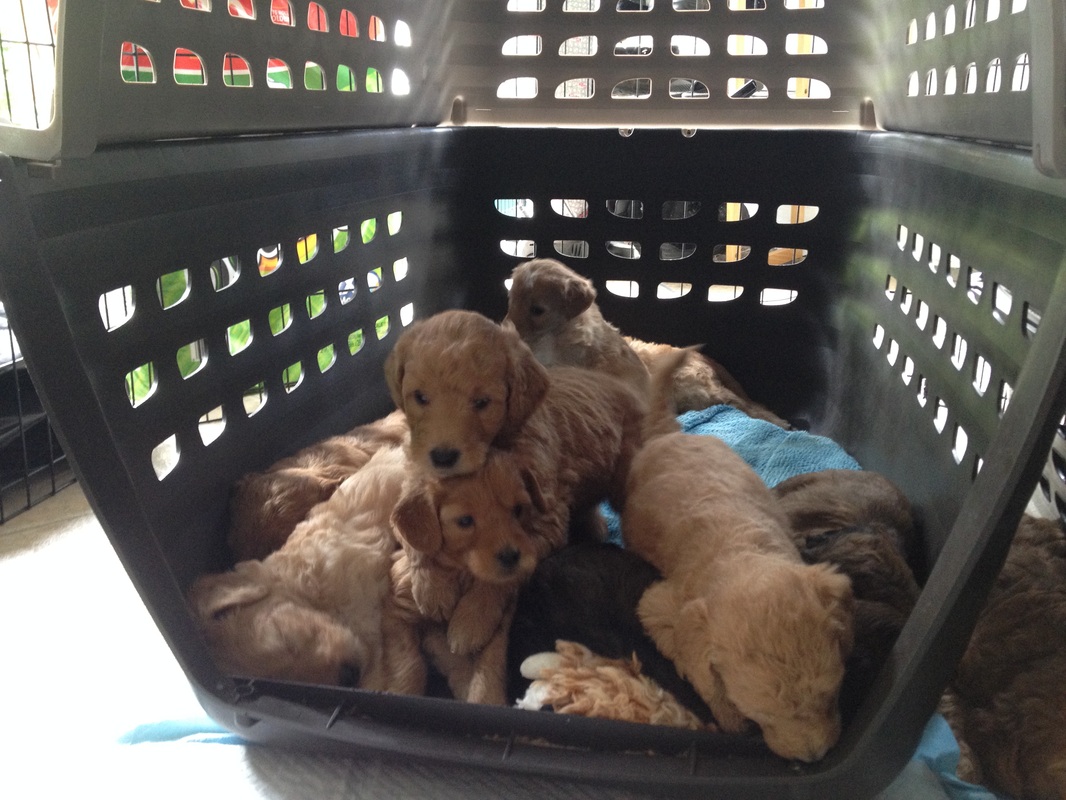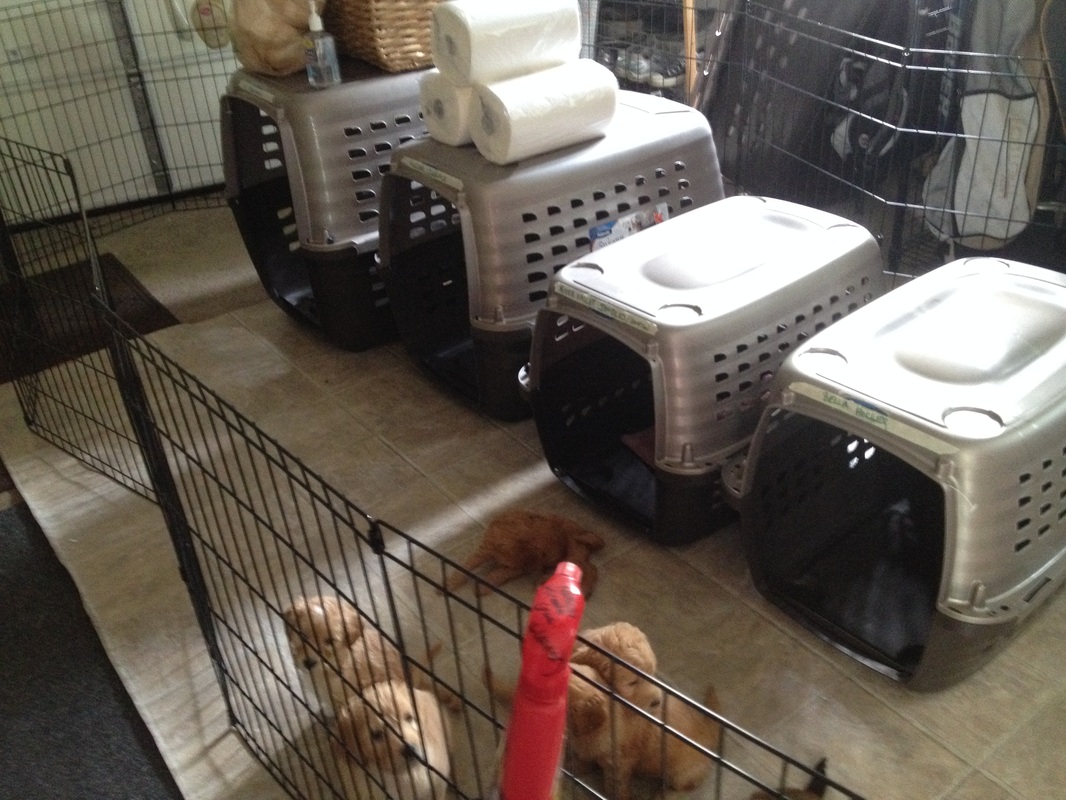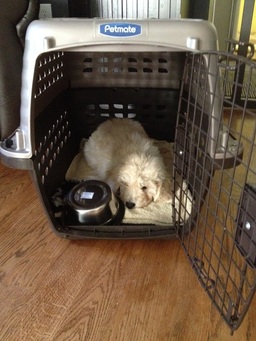Crate Training Your Puppy - Why and How
We are going to tell you how and why you should crate train your puppy or dog, and we are going to show you some of the various options out there. Some of the main choices are hard plastic crates (kennels), metal crates, and exercise pens.
Types of Crates
Our favorite type of crates are the hard plastic ones. These crates, also called kennels, can be taken apart (they are 2 pieces) and broken down for storage. Contemporary ones come with dividers that are called "grow with me" dividers - to make the interior of the crate smaller for when the puppy is really little - so buy once and get a crate with a divider that is the estimated size of your dog as an adult. When picking out the size of the crate needed, you'll see that crates are rated by size of the dog. For example, small crates might be rated for dogs 'up to 20 lbs.' and extra large crates might be rated for dogs 'up to 90 lbs.'. It would be difficult to find a hard plastic crate that would be a good option for a 150 lb. Great Dane because they just don't seem to make them for that size of dog. Hard plastic crates are also the only kind that are airline approved. There are other requirements for airline travel, like water and food cups, but you will see on the labeling if the crate is airline approved. We also think the hard plastic crates are more cozy for puppies. There are not wires or grates that dig into them and they can't break their teeth by chewing on it, like they could with the wire ones.
Wire metal crates are still good options. They break down so much easier and smaller than the hard plastic ones, and there are sizes made for really big dogs. They have a tray that is easy to pull out and clean. They also can be covered with designer covers that match your decor. They are not airline approved and if you have an anxious dog or a chewer, you should watch that they don't break their teeth by chomping on the bars.
Exercise pens are not really crates, but they are a form of containing your puppy. We find them useful for traveling. We can set up a pen quickly no matter where we are - they break down very easily and into a small footprint. Medium to big dogs should not have a pen that is less than 36" tall (they might try to climb it). Pens can also be used in your home, to keep your puppy away from getting himself in trouble by eating the molding or your favorite shoes when you are not watching. We also like to use pens in our backyard because puppies love to eat our landscaping and some of it is toxic to little pups.
Our SHOPPING LIST PAGE has direct links to the sizes and brands that we recommend.
Types of Crates
Our favorite type of crates are the hard plastic ones. These crates, also called kennels, can be taken apart (they are 2 pieces) and broken down for storage. Contemporary ones come with dividers that are called "grow with me" dividers - to make the interior of the crate smaller for when the puppy is really little - so buy once and get a crate with a divider that is the estimated size of your dog as an adult. When picking out the size of the crate needed, you'll see that crates are rated by size of the dog. For example, small crates might be rated for dogs 'up to 20 lbs.' and extra large crates might be rated for dogs 'up to 90 lbs.'. It would be difficult to find a hard plastic crate that would be a good option for a 150 lb. Great Dane because they just don't seem to make them for that size of dog. Hard plastic crates are also the only kind that are airline approved. There are other requirements for airline travel, like water and food cups, but you will see on the labeling if the crate is airline approved. We also think the hard plastic crates are more cozy for puppies. There are not wires or grates that dig into them and they can't break their teeth by chewing on it, like they could with the wire ones.
Wire metal crates are still good options. They break down so much easier and smaller than the hard plastic ones, and there are sizes made for really big dogs. They have a tray that is easy to pull out and clean. They also can be covered with designer covers that match your decor. They are not airline approved and if you have an anxious dog or a chewer, you should watch that they don't break their teeth by chomping on the bars.
Exercise pens are not really crates, but they are a form of containing your puppy. We find them useful for traveling. We can set up a pen quickly no matter where we are - they break down very easily and into a small footprint. Medium to big dogs should not have a pen that is less than 36" tall (they might try to climb it). Pens can also be used in your home, to keep your puppy away from getting himself in trouble by eating the molding or your favorite shoes when you are not watching. We also like to use pens in our backyard because puppies love to eat our landscaping and some of it is toxic to little pups.
Our SHOPPING LIST PAGE has direct links to the sizes and brands that we recommend.
|
|
|
Below is our apricot Goldendoodle puppy, Hudson (from Jada '14), with his thoughtful new owners' exercise pen setup, in their NYC apartment. As you will see in the video, he will sometimes choose to end playtime to go hang out in 'his room'.
So, why train with a crate? Well, puppies can get into things...no matter how puppy proof you think you've made your home. We've had puppies that we thought were in a puppy proof room that managed to eat the wall. Yep. That's right. The drywall. Almost down to the stud. A crate works well for if you need a temporary place to put your puppy while you are doing things that are taking up your attention. This will keep your puppy safe from eating harmful things, even when you turn your head away for just a few minutes.
Another reason why you should crate train is because puppies naturally do not want to mess their crate. This natural instinct can be used to teach them to 'hold it' and go potty on a 'spot' that is away from their crate/living space. Their crate is like their den to them - who pees on the floor in their house? Not puppies. But as they are still little, it is hard for them to understand that your whole house is also their little den and should not be pottied in/on.
If you can't be home in a few hours, do not shut your puppy in a crate!
Crates are not to be used for extended periods of time. A really young pup should not be shut in a crate for more than a few hours. If a puppy makes a mess of his crate, it defeats the purpose of teaching him to be clean and potty outside. They have small bladders and are still developing their digestive systems, so only time and patience will get them to be fully potty trained. A crate will help learn to hold it, longer and longer, as you extend the time they spend in their crate. First, just for a few hours at a time, and eventually, your pup will be able to hold it all day (and all night when you sleep). We do not think you should leave your puppy or adult dog in a crate for longer than 4 to 8 hours. If we are going to be away for more than 4 hours, we hire a dog sitter to come over and walk them. We do the same ourselves! We don't rely on friends and family exclusively, we have professional dog sitters/walkers that are great. Puppies should be allowed to stretch and be mentally stimulated and exercised every day - just like us. While crates are comforting to them, they can also become a place that puppies don't want to be if they are shut in for hours and hours without any mental or physical exercise.
If your puppy cries when you put him in a crate, reassure him and give him a treat. If you throw a treat into the back of the crate every time for the first few weeks that you have your puppy (and make it a good treat), you will see that your puppy happily hops in. We also like to put toys, especially toys that keep them occupied for awhile and that they really like, in the crate with them. We do not put toys with stuffing in them with our puppies because they can pull the stuffing out and eat it.
For nighttime bedtime, try putting the puppy in your bedroom, in his crate, on the floor. You can also put him by himself, but expect more crying. They are lonely if not with their people! Also, keep the crate dark, with blankets, especially if you have a wire metal crate.
Our puppies have a crate as they grow and we do not shut the doors on them because we like them having access to the potty tray. We put our crates in an exercise pen (with the doors off) that has a potty tray. As puppies get older, they don't need access to a potty tray as often, so we shut the doors on the crates. If you are going to be away from your house for more than a few hours and you have a young puppy, try the exercise pen option, with their crate and potty tray, as well as water access. Our primary goal is to keep the puppies safe and clean - and letting them sit in a messy crate will just ruin weeks of good training. So, we clean up any messes quickly and thoroughly.
If you use potty pads, expect puppies to get bored, and like the crinkly sound they make, and shred them. Little tiny pieces of potty pad will be all over. Some puppies won't destroy them, but many will because it's fun! We like to use a potty pad until they are 5 or 6 weeks old, then when they start playing with the pads, we take the pads away and just use a potty tray without the pad. If you are looking for more tips on potty training, check out our potty training page here.
Another reason why you should crate train is because puppies naturally do not want to mess their crate. This natural instinct can be used to teach them to 'hold it' and go potty on a 'spot' that is away from their crate/living space. Their crate is like their den to them - who pees on the floor in their house? Not puppies. But as they are still little, it is hard for them to understand that your whole house is also their little den and should not be pottied in/on.
If you can't be home in a few hours, do not shut your puppy in a crate!
Crates are not to be used for extended periods of time. A really young pup should not be shut in a crate for more than a few hours. If a puppy makes a mess of his crate, it defeats the purpose of teaching him to be clean and potty outside. They have small bladders and are still developing their digestive systems, so only time and patience will get them to be fully potty trained. A crate will help learn to hold it, longer and longer, as you extend the time they spend in their crate. First, just for a few hours at a time, and eventually, your pup will be able to hold it all day (and all night when you sleep). We do not think you should leave your puppy or adult dog in a crate for longer than 4 to 8 hours. If we are going to be away for more than 4 hours, we hire a dog sitter to come over and walk them. We do the same ourselves! We don't rely on friends and family exclusively, we have professional dog sitters/walkers that are great. Puppies should be allowed to stretch and be mentally stimulated and exercised every day - just like us. While crates are comforting to them, they can also become a place that puppies don't want to be if they are shut in for hours and hours without any mental or physical exercise.
If your puppy cries when you put him in a crate, reassure him and give him a treat. If you throw a treat into the back of the crate every time for the first few weeks that you have your puppy (and make it a good treat), you will see that your puppy happily hops in. We also like to put toys, especially toys that keep them occupied for awhile and that they really like, in the crate with them. We do not put toys with stuffing in them with our puppies because they can pull the stuffing out and eat it.
For nighttime bedtime, try putting the puppy in your bedroom, in his crate, on the floor. You can also put him by himself, but expect more crying. They are lonely if not with their people! Also, keep the crate dark, with blankets, especially if you have a wire metal crate.
Our puppies have a crate as they grow and we do not shut the doors on them because we like them having access to the potty tray. We put our crates in an exercise pen (with the doors off) that has a potty tray. As puppies get older, they don't need access to a potty tray as often, so we shut the doors on the crates. If you are going to be away from your house for more than a few hours and you have a young puppy, try the exercise pen option, with their crate and potty tray, as well as water access. Our primary goal is to keep the puppies safe and clean - and letting them sit in a messy crate will just ruin weeks of good training. So, we clean up any messes quickly and thoroughly.
If you use potty pads, expect puppies to get bored, and like the crinkly sound they make, and shred them. Little tiny pieces of potty pad will be all over. Some puppies won't destroy them, but many will because it's fun! We like to use a potty pad until they are 5 or 6 weeks old, then when they start playing with the pads, we take the pads away and just use a potty tray without the pad. If you are looking for more tips on potty training, check out our potty training page here.
Our Goldendoodle Puppies Enjoy Crates, if they are used correctly
|
|

